
Kvinneakt is an abstract bronze sculpture located on the Transit Mall of downtown Portland, Oregon. Designed and created by Norman J. Taylor between 1973 and 1975, the work was funded by TriMet and the United States Department of Transportation and was installed on the Transit Mall in 1977. The following year Kvinneakt appeared in the "Expose Yourself to Art" poster which featured future Mayor of Portland Bud Clark flashing the sculpture. It remained in place until November 2006 when it was removed temporarily during renovation of the Transit Mall and the installation of the MAX Light Rail on the mall.

Animals in Pools is a series of fountains and bronze sculptures of Pacific Northwest animals, designed by American artist Georgia Gerber and located in Portland, Oregon, in the United States. The series was installed in 1986 as part of the renovations associated with construction of the MAX Light Rail. Funded by the Downtown Merchants Local Improvement District, TriMet and the United States Department of Transportation, the sculptures were presented as gifts to the city and remain part of the collection of the City of Portland and Multnomah County Public Art Collection courtesy of the Regional Arts & Culture Council.

Ghost Ship is an outdoor 2001 sculpture by James Harrison and Rigga, a group of local artists, located along the Eastbank Esplanade in Portland, Oregon. It is made of copper, stainless steel, art glass, and two lamps. It is part of the City of Portland and Multnomah County Public Art Collection courtesy of the Regional Arts & Culture Council.
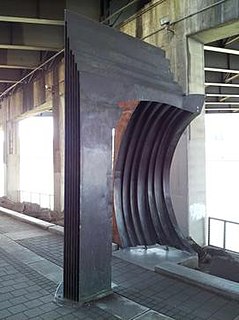
Echo Gate is an outdoor 2001 sculpture by Ean Eldred and the architectural firm Rigga, located along the Eastbank Esplanade in Portland, Oregon, United States. It was funded by the City of Portland Development Commission's Percent for Art program, and is part of the City of Portland and Multnomah County Public Art Collection courtesy of the Regional Arts & Culture Council.

Talos No. 2 is an outdoor 1959–1977 bronze sculpture created by the American artist James Lee Hansen. It is located in the Transit Mall of downtown Portland, Oregon, in the United States.
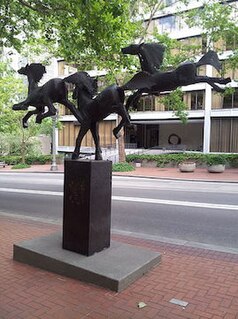
Running Horses is an outdoor 1986 bronze sculpture by Tom Hardy, located on the Transit Mall in downtown Portland, Oregon. It is part of the City of Portland and Multnomah County Public Art Collection courtesy of the Regional Arts & Culture Council.
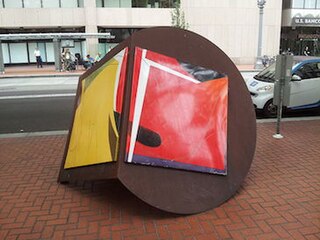
Untitled is an outdoor 1977 steel and porcelain enamel sculpture by American artist John Killmaster, located in downtown Portland, Oregon. It is part of the City of Portland and Multnomah County Public Art Collection courtesy of the Regional Arts & Culture Council.

Driver's Seat is a 1994 galvanized steel sculpture by Don Merkt, installed along the Transit Mall in Portland, Oregon's Old Town Chinatown neighborhood, in the United States. The artwork was funded by the City of Portland's Percent for Art program, the Portland Development Commission, and TriMet, and remains part of the City of Portland and Multnomah County Public Art Collection courtesy of the Regional Arts & Culture Council.
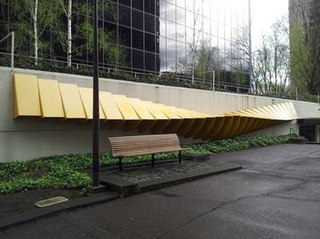
Awning is an outdoor 1976 painted aluminum sculpture by Canadian artist Douglas Senft, located near Southwest 3rd Avenue and Southwest Market Street in downtown Portland, Oregon. The 60-foot (18 m) sculpture was selected and funded by the Portland Development Commission from more than 200 proposals in a request for art intended to "humanize the modern architecture" of the Portland Center. Senft was 26 years old when Awning was installed. It is part of the collection of the Regional Arts & Culture Council. The yellow-colored work is mounted to the side of 200 Market along a pedestrian trail that serves as an extension of Third Avenue.

Vera Katz, also known as Mayor, Vera Katz, is an outdoor bronze sculpture depicting Vera Katz created by American artist Bill Bane. Unveiled in 2006, it is located along the Eastbank Esplanade in Portland, Oregon. Katz, a former mayor of the city between 1993 and 2005, supported arts and culture during her tenure and established Oregon's Percent for Art program. She was also instrumental in developing the Eastbank Esplanade, which is named after her. The sculpture has received a mostly positive reception and has inspired people to adorn it with clothing, flowers and makeup.

Untitled is an outdoor 1977 painted aluminum sculpture by Ivan Morrison, located at Southwest 5th Avenue and Southwest Oak Street in the Transit Mall of Portland, Oregon.

Stack Stalk is an outdoor 2001 sculpture by Ean Eldred and the architectural firm Rigga, located along the Eastbank Esplanade in Portland, Oregon.

Tikitotmoniki Totems is a series of four outdoor 2001 sculptures by American artist Kenny Scharf, located at Jamison Square in Portland, Oregon.
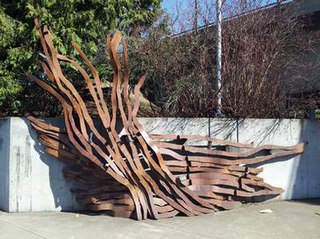
Alluvial Wall is an outdoor 2001 sculpture by Peter Nylen and the architectural firm Rigga located along the Eastbank Esplanade in Portland, Oregon.

Whistlestop for an Organ Teacher is an outdoor 2009 stainless steel sculpture by American artist Cris Bruch, located in Portland, Oregon.

City Reflections is an outdoor 2009 bronze sculpture by Patti Warashina, located in downtown Portland, Oregon.

The Dream, also known as the Dr. Martin Luther King Jr. Memorial Sculpture, is an outdoor bronze sculpture of Martin Luther King Jr. by Michael Florin Dente, located outside the Oregon Convention Center in Portland, Oregon. The 8-foot (2.4 m) memorial statue was dedicated on August 28, 1998, the 35th anniversary of King's "I Have a Dream" speech. It depicts King plus three allegorical sculptures: a man who symbolizes the American worker, a woman who represents immigration, and a young girl shown releasing King's coattail, who represents, according to Dente, the "letting go" that occurs when people sacrifice their time and energy to engage in a struggle. The sculpture is part of the City of Portland and Multnomah County Public Art Collection, courtesy of the Regional Arts & Culture Council.
TriMet is an outdoor 1977 aluminum sculpture by American artist Robert Maki, installed on the Mount Hood Community College campus in Gresham, Oregon, United States. According to the Regional Arts & Culture Council, which administers the work, "TRIMET serves as an excellent example of how Maki's technical background is reflected in his work. The sculpture is built of geometric shapes that evolve and morph as the viewer moves around it, using negative space to help define the mass of the sculpture itself." It measures 8 ft × 9.25 ft × 4 ft and was funded by TriMet and the United States Department of Transportation.

Untitled is an outdoor 1977 stainless steel sculpture by American artist Bruce West, installed in Portland, Oregon, in the United States.
Silicon Forest, sometimes referred to as The Silicon Forest, is an outdoor 2003 sculpture by Brian Borrello, installed near the Interstate/Rose Quarter station in Portland, Oregon's Lloyd District, in the United States.




















